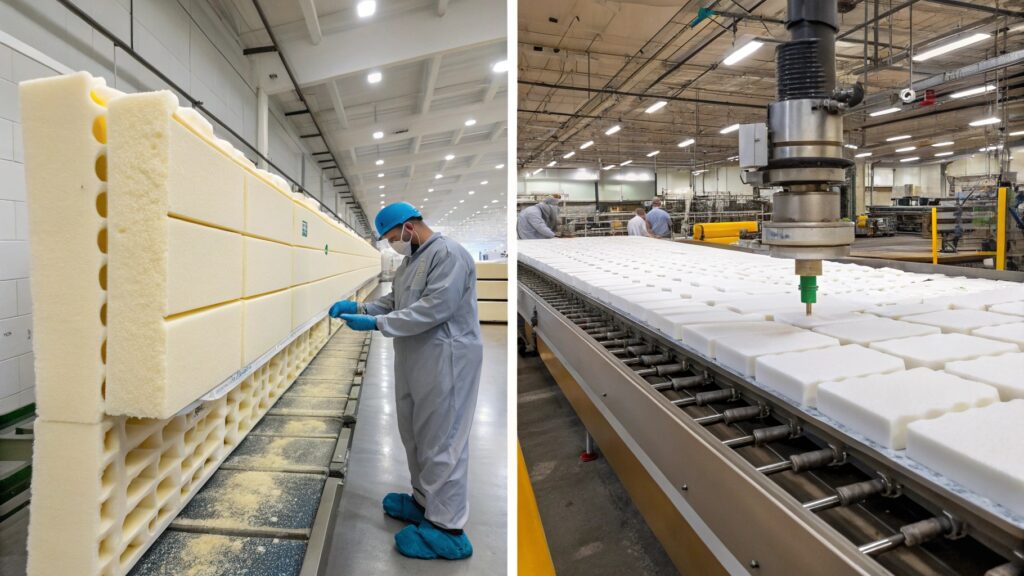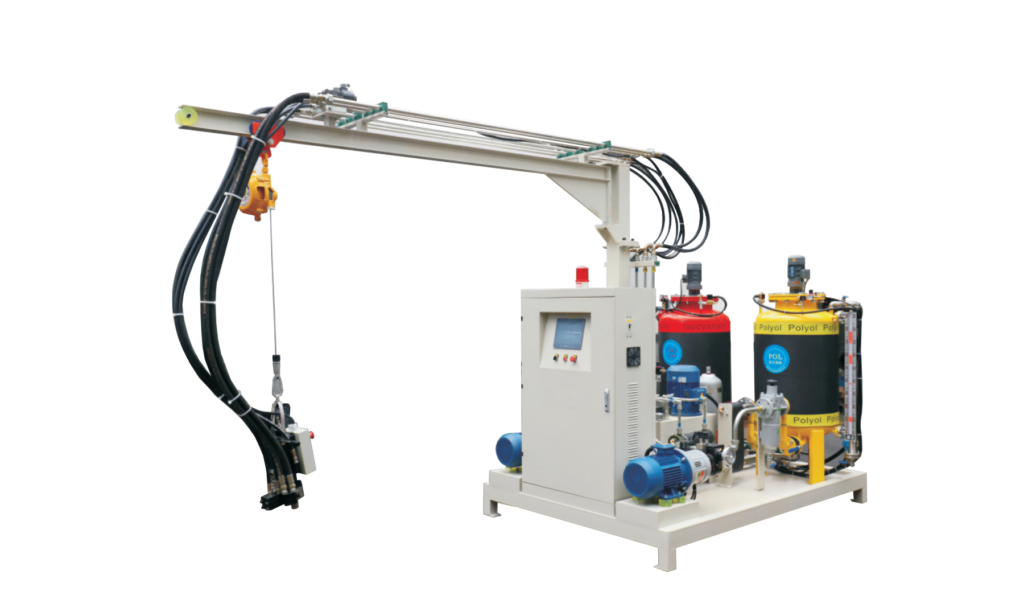I know how frustrating it is to watch production cycles drag on. In refrigerator manufacturing, polyurethane (PU) foam injection is a critical step, and any bottleneck here can significantly impact overall output. Imagine the competitive edge you’d gain by shaving off 20-40% of your cycle time – more refrigerators rolling off the line, happier customers, and a healthier bottom line. Are you ready to unlock that potential?
The good news is, you absolutely can reduce cycle time in polyurethane foam injection for refrigerator manufacturing. By optimizing your raw material formulation, upgrading your equipment, and streamlining your processes, you can achieve significant gains in efficiency and throughput.

Want to learn exactly how to optimize your PU foam injection process and dramatically reduce your cycle times? Keep reading – I’m going to walk you through the key strategies and show you how to implement them in your own facility.
Optimize PU Foam Machine Performance
Let’s start with the heart of your PU foam injection process: the machine itself. A well-maintained and optimized machine is crucial for consistent and efficient operation. Here’s how to get the most out of your equipment:
Regular Maintenance and Calibration
Just like any precision machinery, your Máy tạo bọt PU needs regular maintenance to perform at its best. This includes:
- Preventive maintenance schedules: Implement a routine check-up plan to identify and address potential issues before they cause downtime.
- Nozzle cleaning and inspection: Clogged nozzles are a common cause of delays. Regularly clean and inspect nozzles to ensure proper material flow.
- Calibration of metering pumps: Accurate metering is essential for consistent foam quality. Calibrate your pumps regularly to maintain the correct mixing ratio.
Kiểm soát nhiệt độ
Maintaining the correct temperature of your raw materials and the machine itself is vital for consistent reaction times.
- Preheating systems: Consider preheating your polyol and isocyanate components to around 25-30°C to reduce viscosity and speed up the reaction1.
- Insulated tanks and lines: Use insulated tanks and lines to maintain consistent temperatures and prevent heat loss.
- Temperature monitoring: Implement a system to monitor temperatures throughout the process and make adjustments as needed.
Máy tạo bọt áp suất cao
Upgrading to máy tạo bọt áp suất cao can significantly reduce cycle times. High-pressure systems (10–21 MPa) ensure precise mixing and rapid injection, reducing foam expansion time by 15–30% compared to low-pressure machines1. Also, machines with dynamic ratio control minimize waste and downtime during material switches.
| Tính năng | Low-Pressure Machines | High-Pressure Machines |
|---|---|---|
| Mixing Pressure | Lower | Higher (10-21 MPa) |
| Mixing Precision | Less Precise | More Precise |
| Foam Expansion Time | Longer | Shorter (15-30% less) |
| Material Waste | Hơn | Less |
| Downtime During Material Switches | Hơn | Less |

Improve Raw Material Formulation
Các raw materials you use have a direct impact on the speed and quality of your foam injection process. Optimizing your formulation can lead to significant reductions in cycle time.
Fast-Curing Polyurethane Systems
Using fast-curing polyurethane systems with tailored catalysts and blowing agents can accelerate reaction times1. Work closely with your raw material suppliers to develop custom formulations that balance speed and insulation performance. UREXCEED collaborates with well-known raw material suppliers to ensure the stability and high performance of every batch, helping customers improve product quality while reducing production costs1. Additionally, we offer raw material formulation development services, customizing formulations to meet specific customer requirements1.
Raw Material Quality and Consistency
It’s not just about the formulation, but also about the quality and consistency of your raw materials.
- Consistent viscosity: Ensure that your polyol and isocyanate have consistent viscosity from batch to batch.
- Moisture control: Polyurethane is highly sensitive to moisture, which can cause unwanted reactions and delays. Store your raw materials in a dry environment and use desiccants if necessary.
- Regular testing: Regularly test your raw materials to ensure they meet your specifications and haven’t degraded over time.
Partner with Suppliers
Don’t be afraid to collaborate with your raw material suppliers to fine-tune your formulations and address any issues you’re experiencing. They can provide valuable insights and expertise to help you optimize your process.

Enhance Molding and Demolding Efficiency
The molding and demolding stages can be significant bottlenecks in the overall cycle time. Streamlining these processes can yield substantial improvements.
Thiết kế khuôn mẫu
The design of your molds plays a crucial role in heat transfer and demolding ease.
- Thin-wall molds with high thermal conductivity: Thin-wall molds made from materials with high thermal conductivity, like aluminum alloys, dissipate heat faster, speeding up curing1.
- Vacuum-assisted molding: Vacuum-assisted molding minimizes air traps, reducing deflashing time1.
- Easy-release coatings: Apply easy-release coatings to your molds to facilitate demolding and prevent damage to the foam.
Demolding Techniques
Efficient demolding is essential for minimizing downtime between cycles.
- Quick-release mold clamps: Use quick-release mold clamps to reduce setup time1.
- Ejection systems: Implement mechanical or pneumatic ejection systems to quickly and safely remove the foam from the mold.
- Cooling systems: Consider using cooling systems to reduce the temperature of the mold and foam before demolding, making it easier to handle.
Automate and Streamline Production
Automation is your best friend when it comes to reducing cycle time. Automating repetitive tasks not only speeds up the process but also reduces the risk of human error.
Robotic Mold Handling
Integrate robotic arms for rapid mold loading/unloading, cutting idle time between cycles1. Robots can perform these tasks with greater speed and precision than humans, leading to significant time savings.
Conveyor Systems
Implement conveyor systems to move molds and parts between stations automatically. This reduces manual handling and ensures a smooth, continuous workflow.
Parallel Processing
Staggered production lines allow concurrent foaming and demolding operations1. Use rotating turntables for continuous workflow1. This approach maximizes throughput by performing multiple tasks simultaneously.
Monitor and Troubleshoot Process Bottlenecks
Even with the best equipment and processes, bottlenecks can still occur. The key is to monitor your process closely and identify and address any issues quickly.
Giám sát thời gian thực
Deploy Manufacturing Execution Systems (MES) to monitor real-time parameters (e.g., temperature, pressure) and adjust settings dynamically1. Predictive maintenance alerts can prevent unplanned stops1.
Data Analysis
Collect and analyze data on cycle times, downtime, and material usage to identify areas for improvement. Use statistical process control (SPC) techniques to monitor process stability and detect trends.
Employee Training
Train operators to minimize manual interventions and troubleshoot common delays (e.g., nozzle clogging)1. Well-trained operators can quickly identify and resolve issues, minimizing downtime and keeping your production line running smoothly.
Invest in Advanced Equipment
Sometimes, the best way to reduce cycle time is to invest in advanced equipment that offers superior performance and features.
High-Precision Metering Systems
Invest in metering systems that offer precise control over the mixing ratio of your raw materials. This ensures consistent foam quality and minimizes waste.
Automated Cleaning Systems
Consider automated cleaning systems for your molds and equipment. These systems can quickly and efficiently remove residue and contaminants, reducing downtime and improving foam quality.
Energy-Efficient Designs
Opt for equipment with energy-efficient designs to reduce operating costs and minimize your environmental footprint.
Phần kết luận
Reducing cycle time in polyurethane foam injection for refrigerator manufacturing is a multifaceted challenge that requires a holistic approach. By optimizing raw material formulation, upgrading equipment, enhancing molding and demolding efficiency, automating production, monitoring for bottlenecks, and investing in advanced technologies, manufacturers can achieve significant reductions in cycle time while maintaining or even improving product quality. As UREXCEED, we are committed to providing comprehensive solutions, including high-quality PU foam machines, raw materials, and customized production lines, to help our clients achieve their manufacturing goals. Contact us today to learn more about how we can help you optimize your PU foam injection process and boost your bottom line.1
[^1]: UREXCEED, Multiple pages on Ureceed Website, https://urexceed.com/.
